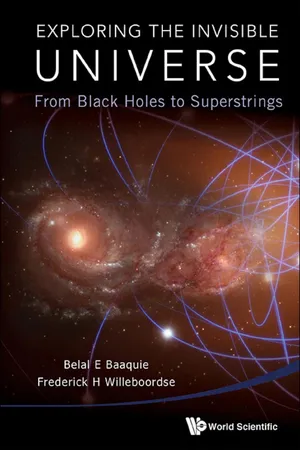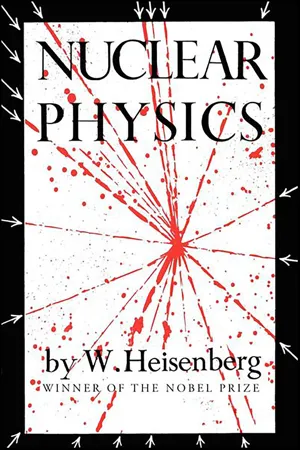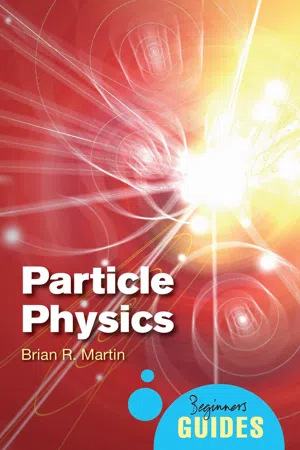Physics
Fundamental Forces
Fundamental forces are the four basic interactions in nature: gravity, electromagnetism, the weak nuclear force, and the strong nuclear force. These forces govern the behavior of all matter and energy in the universe. Each force has specific characteristics and ranges of influence, and they play a crucial role in shaping the structure and behavior of the physical world.
Written by Perlego with AI-assistance
Related key terms
Related key terms
1 of 4
Related key terms
1 of 3
10 Key excerpts on "Fundamental Forces"
- eBook - ePub
Exploring The Invisible Universe: From Black Holes To Superstrings
From Black Holes to Superstrings
- Belal E Baaquie, Frederick H Willeboordse(Authors)
- 2015(Publication Date)
- WSPC(Publisher)
In the broadest classification of all forms of physical entities, the constituents of matter, namely quarks and leptons, are fermions and it will be shown that all the Fundamental Forces of Nature are bosons. The electromagnetic and gravitational forces are familiar from classical physics and from our direct perception of the world around us. We have vision due to our perception of electromagnetic waves and we feel our weight due to gravity. The strong force is required to confine the quarks into bound states of protons and neutrons that form the nuclei of all atoms. Recall that the nucleus being composed of protons and neutrons has a net positive charge with a very short distance separating the protons; the positive charges do not fly apart since another force stronger than Coulomb repulsion binds the protons in the nucleus, namely the strong force. The existence of weak interactions is a bit more difficult to observe. Neutrons are stable inside the nucleus but are unstable when isolated outside a nucleus, with a lifetime of 882 s. The decay of the neutron, along with strangeness changing decays of hadrons, as discussed in Sec. 11.14, are so slow that only a weak force (and not the electromagnetic or strong force) can account for it. The weak force also describes the (non-electromagnetic) interactions of leptons with each other and with the quarks. Gravitation — as discussed in Chapter 4 — is not a force in the Newtonian sense, but instead is a manifestation of the curvature of spacetime; in contrast, the other three interactions are completely described by quantum mechanical processes - eBook - ePub
- Ritesh Kohale, Sanjay J. Dhoble, Vibha Chopra(Authors)
- 2009(Publication Date)
- Bentham Science Publishers(Publisher)
The electromagnetic force embraces atoms and molecules structured. In detail, the forces of electrical attraction and repulsion of electric charges are so prevailing over the other three Fundamental Forces that they can be well-organized to be irrelevant as determiners of atomic and molecular structure. Even magnetic extraordinary effects are characteristically apparent only at high determination and as slight expansions.4.4. Gravitational Forces
Gravitation is a normal occurrence by which all belongings with mass or energy, including planets, stars, galaxies, and even light [71 ], are attracted to one another. Gravity has an infinite range. However, its special effects become weaker as entities get further away. Gravity is most accurately well-defined by the general theory of relativity (anticipated by Albert Einstein in 1915), which describes gravity not as a force but as a degree of masses moving together with geodesic appearances in a frizzy space-time created by the irregular scattering of mass. The black hole is one of the most thrilling illustrations of this curvature of space-time, from which nothing, not even light, can outflow once past the black hole's existence forecasts [72 ].Gravity is the weakest of the four fundamental interactions of physics, about 1038 times weaker than the strong interaction, 1036 times weaker than the electromagnetic force and 1029 times weaker than the weak interaction. As a result, it has no important effect at the level of subatomic particles [73 - eBook - ePub
- W. Heisenberg(Author)
- 2019(Publication Date)
- Philosophical Library/Open Road(Publisher)
5. THE NUCLEAR FORCESI. GENERAL PROPERTIES OF THE NUCLEAR FIELDThe cohesion of protons and neutrons within the atomic nucleus is ensured by forces, to which we have referred as nuclear forces, although we have not yet discussed their nature. The electric forces of repulsion, which are also operative in the nucleus, exert a purely disruptive effect. What can we learn today from the experiments on the nature of these nuclear forces? Let us first study briefly the form which an answer to this question must take. Assuming that we did not as yet know what electric forces were, how could we begin to explain their nature? We could begin by stating that electric charges mutually repel each other, with a force which decreases inversely as the square of the distance between them. According to the knowledge gained in the early part of the nineteenth century, we could add that a fundamental relationship exists between electric and magnetic forces—e.g.: varying electric forces always generate magnetic forces, and vice versa. Moreover, we might add that the phenomena of light, which used to be regarded as something of a special nature, are among these electromagnetic phenomena, and are simply nothing but electromagnetic waves. The next step would be to note that in certain experiments light appears not as a wave, but as flying particles, in other words, in the shape of photons, and thus we would discover a relationship between the electromagnetic field and these photons. A truly exhaustive description of electromagnetic forces can, however, be given solely with the aid of mathematical equations, expressing how electromagnetic forces change and spread. A complete picture of the ‘nature’ of these phenomena is supplied only by Maxwell’s equations in combination with the equations of the quantum theory.But as for the nuclear forces we have not got to them yet. Nevertheless, we can already form a picture of them, which is correct qualitatively at least and includes as many details as the picture of the electromagnetic forces—except for the exact mathematical formulae. - eBook - ePub
- Chris Webster(Author)
- 2012(Publication Date)
- Routledge(Publisher)
The same laws of motion that extend to all living things will also apply to alien life forms, if they exist. However weird and wonderful, these life forms will be required to comply with those same laws of physics that govern the ones found on earth. A number of forces, objects, and matter are more familiar to physicists and cosmologists than the rest of us. Although we may know that these things exist, or at least we believe them to exist insofar as theories point to their existence, the possible impact on our everyday lives by such exotic concepts as dark matter, dark energy, and dark flow may not be of such urgent importance to us. On a day-to-day basis, these phenomena are not clearly evident to us; once again, though they may be of interest, they seem to have little impact on the way we live our lives or the manner in which we generally see that things behave. Let’s therefore concentrate for the time being on those four main forces that do impact our lives: gravity, electromagnetic force, weak nuclear force, and strong nuclear force. Of these four forces, it is only gravity that is clearly evident to us and impacts upon the way we live our lives. It is gravity that will determine the work we make as animators; so it is gravity on which we will concentrate in our study. For now it may be interesting to discuss, at least briefly, the other three forces and see how gravity sits alongside them. The Weak Nuclear Force The weak nuclear force is the weakest of the three other forces after gravity; its effects are swamped by both the electromagnetic force and the strong nuclear force. The range over which the weak nuclear force is effective is extremely limited and extends over only a very small region of space. It doesn’t even work at a microscopic level but works at a subatomic level. The weak nuclear force enables the transmutation of subatomic particles that often results in these particles accelerating at very high speeds - eBook - ePub
Particle Physics
A Beginner's Guide
- Brian Martin(Author)
- 2011(Publication Date)
- Oneworld Publications(Publisher)
40 – and their associated fields are negligible.)The electromagnetic force is transmitted through the constant exchange of photons between the atom’s nucleus and its electrons. Photons serve as ‘force carriers’ of the electromagnetic interaction, much like a situation where two people ‘communicate’ by exchanging a ball between one another. If the ball is very light, the people are able to pass it over large distances, but as the mass of the ball increases the distance that can be covered is reduced. This analogy holds for particles: the heavier the particle being exchanged, the shorter the ‘range’ of the force; that is, the shorter the distance over which the force is significant. In fact, the range of a force is proportional to the inverse of the mass of the exchanged particle. Because photons have zero mass, the electromagnetic force is said to have an infinite range.The same exchanges occur between each of the protons in the nucleus. Following the rule for electric charges that ‘like charges repel and unlike charges attract’ would mean that these exchanges between protons would quickly blow the nucleus apart, so there must be an attractive force as a balance. This attractive interaction is the strong nuclear force . It is the same for protons and neutrons and is independent of electric charge. Adding neutrons to a nucleus adds mass and increases the attractive binding force without, for the most part, decreasing the stability of the nucleus. The balance between the strong nuclear force and electromagnetism largely determines why the heaviest naturally-occurring stable nucleus is uranium, which has 92 protons and 146 neutrons in its most common form. Particles that experience the strong nuclear interaction, such as nucleons and the short-lived resonances that were discovered in the 1940s and 50s, are known as hadrons - eBook - ePub
- Andrew Rex(Author)
- 2014(Publication Date)
- CRC Press(Publisher)
Chapter 8Fundamental Particles and Forces
Some of the most exciting recent discoveries in physics have to do with fundamental particles. For many centuries people have observed matter and wondered about its composition. A common working assumption, which goes back as far as the ancient Greeks, is that there exists a relatively small number of elementary or fundamental particles, and that the vast variety of things we see in nature can be explained by different arrangements of those few particles. Starting in the late nineteenth century, physicists began to develop the kinds of experimental tools that can determine the ultimate composition of matter. Throughout the twentieth century, more refined and elaborate equipment revealed many details about the particles that make up everything. Patterns began to emerge and, based on those patterns, theories were developed to help physicists classify and understand the particles’ properties and their interactions with one another. Along with this came a new conception of Fundamental Forces as the manifestations of particle exchanges. The connection between fundamental particles and forces is one of the most important discoveries in modern physics.What Are Fundamental and Composite Particles?
The idea of a particle may seem obvious enough. You might consider as an example the smallest thing you can see, such as a grain of dust or pollen. However, those objects are very large compared to what a physicist thinks of as a particle. Your vision is limited by the focusing power of your eyes, and even when aided by a good microscope, you can’t see detail finer in size than the wavelength of the light you’re using to view the object. Atoms are much smaller than a grain that you can see, and fundamental particles are much, much smaller than atoms.A fundamental particle is one that can’t be broken down into anything smaller. A composite particle - eBook - ePub
Understanding the Universe
From Quarks to the Cosmos
- Don Lincoln(Author)
- 2004(Publication Date)
- WSPC(Publisher)
The charged leptons are not affected by the strong force, but feel the rest. The neutrinos are the least gregarious of the particles, affected only by the weak force and gravity. Because gravity is somehow a bit different, a word or two is in order. It is the mass (or equivalently energy) that causes gravitational interactions. Because gravity is intrinsically so weak and because the masses of the particles are so small, we are unable to do experiments to see how it really works at such small size scales. Since the strength of the gravity force is so small, we disregard it in the remaining discussions. The interrelationship between the particle types and the forces they feel are given in Figure 4.5. Another important parameter when comparing the forces is their respective strengths. As we have seen in our earlier discussions, the strength of the forces depends on the distance between the two particles under consideration, which means that the results of the comparisons of the strengths of the various forces are distance-dependent. If we take the size of the proton (10 –15 meters) as a good size, we can do the comparisons. In order to make the information easier to understand, we define the strength of the strong force to be unity (i.e. 1) and give the strength of all of the other forces in comparison, for instance a force of 0.5 is half as strong as the strong force, while 0.01 would be 100 times weaker. The strengths of the respective forces are given in Table 4.1. The numbers given in Table 4.1 are for matter under normal conditions, not in the massive particle accelerators in which we do experiments - eBook - ePub
- John M. Blatt, Victor F. Weisskopf(Authors)
- 2012(Publication Date)
- Dover Publications(Publisher)
CHAPTER III Nuclear Forces 1. INTRODUCTION The theoretical study of nuclear structure is appreciably more difficult than the study of the structure of atoms and molecules, because the basic law of force is not known. The difficulties encountered in atomic and molecular physics lie in the application of well-known force laws. The forces between electrons and atomic nuclei are entirely determined by the electromagnetic laws. Nuclear physics is beset not only by the difficulties of quantum mechanics applied to complicated systems, but also by the additional difficulty that we do not know the laws governing the nuclear forces. Thus, apart from the difficulty of handling the wave equation for a many-body system, we do not even know which wave equation to solve. The problem in nuclear physics is therefore two-fold: first, to find the laws of the nuclear forces and, second, to calculate the nuclear properties resulting from those forces. Since at present there is no satisfactory fundamental theory of nuclear forces, their nature can be studied only by careful analysis of the properties of known nuclei. We must try to find the law of force which, when applied to the nuclei, will reproduce the observed properties. The difficulties of this attempt are obvious. One is experimental: our knowledge of nuclear properties is not very accurate, so there may be several laws of force whose implications are in agreement with the present experimental material. An example of this is provided by the insensitivity of low-energy neutron-proton and proton-proton scattering data to the detailed distance dependence of the nuclear potential in the S states cf the two-nucleon systems. All we were able to determine was the scattering length and the effective range, i.e., only two parameters - eBook - ePub
Information and the World Stage
From Philosophy to Science, the World of Forms and Communications
- Bernard Dugué(Author)
- 2017(Publication Date)
- Wiley-ISTE(Publisher)
Spin describes a process of communication inherent to matter and will allow us, in the context of quantum physics, to understand electric force as a result of the physics of communication. In other words, electric force, which can be likened to a “desire of matter”, relies on the communication of material apparatuses in terms of the dynamic interface represented by the electron with its charge and spin, which links an external space to an inner place, as is also pointed out by the monadological concept of matter I am building. Communication and appetition. These two terms perfectly describe electric force by turning around polarity, communication and aversion. Electric interactions are also involved in the reactions, and other blends observed in chemical experiments or the analysis of the molecular processes of the living world. All these processes take place with communication carried out in terms of electronic interfaces. Quantum physics allows us to predict with good approximation the shapes of electron clouds and the resulting molecular structures. However, it is quantum electrodynamics that provides a more precise explanation of the phenomena at play, for example, the Van der Waals forces, which can be explained based on the exchanges of virtual particles that actually represent elementary communications.Thus, the electric force is at the root of how we see and the manner of looking and being attracted or repelled by the things of the environment. Mechanical forces constitute the foundations of action, movement and changes in arrangement. Human experience can distinguish between the electric power involved in looking or seeing, and the inner energy that determines the movement of the body. These are two universal characteristics of the world. Matter can thus be informed and, if required, keep this information and organize it so as to include it in a (metaphysical) content.Electricity cannot be separated from its “physical partner”, namely magnetism. This property of matter has also been highlighted by mechanical phenomena, for example, when we take a magnet and throw some iron filings. As it falls, each iron filing is affected by the presence of the magnetic field and falls in a shape supposed to represent the lines of the field. Let us take two magnets shaped like a coin, with a north face and a south face that represent the two magnetic poles. Let us place the first magnet on a table with the south face upwards, and then place the second magnet on the first one with the south face downwards. A repulsive force will consequently be generated and if we let the process unfold, the magnet on top will rotate and then cling to the magnet below, this time with the north facing the south pole. - eBook - ePub
After the Beginning
A Cosmic Journey through Space and Time
- Norman K Glendenning(Author)
- 2004(Publication Date)
- WSPC(Publisher)
Fig. 4.5. Hideki Yukawa, professor of theoretical physics at Kyoto University, conceived the idea that the strong nuclear force, one of the four Fundamental Forces of nature, is caused by a messenger particle that he called a meson, later discovered and called a pion. The other three are the weak nuclear force, the gravitational force, and the electromagnetic force. © The Nobel Foundation, with permission.Hideki Yukawa (1907–1981), a theoretician in Kyoto, puzzled over these mysteries; by combining relativity and quantum theory he succeeded in describing the attraction between nucleons7 by a messenger particle (or force carrier) that he called a meson—a new and so-far-undiscovered type of particle.8 Yukawa (Figure 4.5 ), who won the Nobel Prize for his insight, was able to infer the approximate mass of the hypothetical particle, the mediator of the attractive nuclear force, from the internucleon spacing in the nucleus.9 The pion was discovered 14 years later. Here, yet, is another example where a mystery was solved by proposing the existence of a particle and some of its properties, which only years later was actually discovered. (Other instances are Dirac's antielectron (Section 4.2 ), Gell-Mann's quarks (this chapter), and Pauli's neutrino (Section 5.4.3 ).The constitution of the atom was now known if one probed no further. A central small nucleus contained neutrons and protons, which were bound together by the strong nuclear force. The nucleus was surrounded at a great distance by electrons. The number of electrons exactly balanced the number of protons. As we shall discover later, the number and their arrangement into shells gave to each element its distinctive chemical properties. Any element may have some slight variations known as isotopes, which differ only in the number of neutrons and therefore the atomic weight of the element.Now the time was ripe to milk the discoveries of Marie and Pierre Curie, of J.J. Thompson, and of E. Rutherford, and the wealth of spectral data on atoms that had been accumulated over the course of a century for the insights they might yield into the structure of matter.
Index pages curate the most relevant extracts from our library of academic textbooks. They’ve been created using an in-house natural language model (NLM), each adding context and meaning to key research topics.
Explore more topic indexes
Explore more topic indexes
1 of 6
Explore more topic indexes
1 of 4









